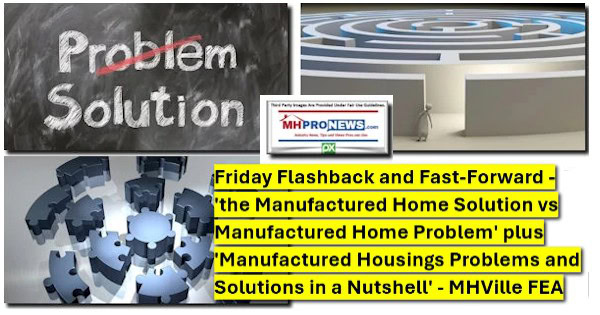When over half the country, per Edelman, believes that public officials and business leaders can’t be trusted, and Pew Research shows trust in mainstream media as low, it makes sense to carefully document and examine properly-reasoned evidence. Yes, common sense may be under assault in an epoch when emotion and feelings are given so much attention, nevertheless, swimming against the current is what salmon and humans are both able to do. James A. “Jim” Schmitz Jr. and his economist colleagues like John “The Grumpy Economist” Cochrane have advanced a notion of “sabotaging monopolies.” In their thesis, they make several claims that include the broader economy. But they have specifically made allegations relevant to manufactured housing. Those claims by Schmitz and company include the assertion that HUD, various builders, and nonprofits such as the National Association of Homebuilders (NAHB) have deliberately sabotaged more affordable housing options that involve factory-building. They specifically named manufactured homes as being sabotaged. Are they right, wrong, or somewhere in between? While the case can be made that some of their work merits terminology or other refinement, they themselves have said it is a work in process. That noted, their serious claims merit an authentic logical test that is systematic and uses real world evidence. That evidence should reasonably include what HUD has said and done. The test cases examined herein will peer at HUD’s Operation Breakthrough recap and the 2019 Innovative Housing Showcase (IHS).
Before progressing, a quick aside is warranted on systematic and logical thought.
“Thomas Aquinas (1225–1274) was a systematic thinker,” says Aquinas about Thomism. “He developed his philosophy and theology within an intellectual framework called metaphysics. In our times it seems necessary to add that he worked within classical metaphysics, the one founded by Aristotle. It is hard to understand Aquinas’s arguments without knowing the principles of classical metaphysics.” Stanford University’s website states “Aristotle’s logic, especially his theory of the syllogism, has had an unparalleled influence on the history of Western thought.” It continues, “All Aristotle’s logic revolves around one notion: the deduction (sullogismos).” “Each of the “things supposed” is a premise (protasis) of the argument, and what “results of necessity” is the conclusion (sumperasma).” Aquinas and Aristotle were and remain among the intellectual giants in understanding how to think rationally and objectively.
Notice the word ‘argument’ here means a logic argument, something that is often misunderstood in an era that may overemphasize ‘feelings’ and ‘safe spaces.’ While it makes atheists nervous, God gave man both reason and emotion. When in proper balance, logic and emotion combined yield amazing insights…and action.
Using a neo-Thomistic and Aristotelian systematic method, one should test Schmitz and his colleagues claims through strong real-world arguments against their charges. Thus, this reason-based look at HUD’s Operation Breakthrough recap and the Innovative Housing Showcase. The emotional part will follow further below.

Operation Breakthrough: Todd M. Richardson, HUD’s Office of Policy Development and Research (PD&R)
The HUDUser website says that, “Todd Richardson heads HUD’s research arm of approximately 145 staff that manage national surveys, conduct and manage research and program evaluations, and develop program parameter data to support HUD’s major programs.” He is the top man there, even though that factual statement may make some PC types wince.
Richardson, in an undated blog post that MHProNews reported on in depth on June 1, 2018, said the following.
“Periodically, I find it helpful to look back at the early days of the Office of Policy Development and Research (PD&R).” Hmmm, using reason and common sense, MHProNews concurs that looking back at the evidence and claim, along with looking around, and then seeing what has occurred are good.
“Today’s post is about a very different PD&R demonstration, a massive effort to change how we build housing in the United States. In the late 1960s and 1970s, PD&R ran a demonstration called Operation BREAKTHROUGH.”
Thompson said, “When the National Academy of Sciences [NAS] reviewed PD&R in 2008, it summarized the core lessons from Operation BREAKTHROUGH as follows…” “Operation Breakthrough’s failure was attributed to the attempt by government to introduce technologies in an arena in which it had no procurement interest.”
Thompson, citing NAS, says the project to build more industrialized housing and manufactured homes was a “failure.”
Several factors are cited. But what was not mentioned were the words “enhanced preemption” that federally regulated manufactured housing enjoys. For that matter, the words “preemption” are not used in his look back at Operation Breakthrough either.

Given the point that HUD Code manufactured homes has as their primary federal regulatory – wait for it, HUD – isn’t it rather odd that Thompson magically manages to miss what might be a key reason that manufactured housing has never performed at the same level as pre-HUD code mobile homes achieved?
That point merits emphasis, so it is not missed. HUD has the legal tool to make more manufactured homes available. But they have routinely failed to do so. It is found in the the Manufactured Housing Improvement Act of 2000 (MHIA or 2000 Reform Law). Conveniently, the phrase “preemption” or “enhanced preemption” are missing on key parts of their own websites. But for the sake of new readers, to emphasize the meaning of the law, is this screen capture from Democratic lawmakers who called the Bush Administration’s HUD Secretary Mel Martinez on the carpet for not using their enhanced preemption powers.

When voices across the left-right divide and from a range of disciplines inside or outside of manufactured housing agree that local zoning barriers to HUD Code manufactured homes are near the heart of the issues that keep manufactured housing underperforming. How could HUD’s Thompson have missed that critical point? Hold that thought.
Put differently, so far, Schmitz and his colleagues claim that HUD has – at a minimum – failed to properly support manufactured housing, and is de facto benefiting NAHB and others is holding up. That failure to enforce the 2000 reform law’s enhanced preemption of HUD Code manufactured homes has spanned the Bush-Cheney administration and the Obama-Biden administration.
But what about the Trump-Pence years? Let’s look.
Those points noted, this MHProNews analysis will now pivot to a more recent event. That would be the HUD and NAHB backed Innovative Housing Showcase (IHS) that occurred in 2019 during HUD Secretary Ben Carson’s term in office.
In fairness, it should be noted that the Secretary Carson term at HUD produced by far the most pro-manufactured housing evidence and arguments. However, how did they do in terms of moving the needle on preemption? A look at the IHS 2019 and some related items from HUD’s own website tells the tale.
Innovative Housing Showcase 2019
The Innovative Housing Showcase (IHS) 2019 on the HUD website could be cited as evidence that HUD and NAHB specifically attempted to promote HUD Code manufactured homes, along with other kinds of factory-built housing. On its face, that would seem to defeat Schmitz’s claims. National and local media came. HUD Secretary Carson and other speakers said lots of nice things. Manufactured homes provided by members of the Manufactured Housing Institute (MHI) were there for inspection.
Does that mean that Schmitz and company are thereby proven wrong? Not necessarily. Because there were ‘efforts’ with Operation Breakthrough that ultimately failed. Did IHS result in a surge of sales or less zoning barriers? Hardly.

For brevity’s sake, the deeper dive on this is found in the document linked here. It reflects this point. Neither on the IHS, nor on any of the HUD PD&R pages, is there any clear evidence that the Manufactured Housing Improvement Act (MHIA) of 2000 mandated preemption – sometimes called “enhanced preemption” is mentioned. It is not on the IHS page. Using their own site search tool, it is nowhere to be found on the entire HUD PD&R website.

No doubt Aquinas and Aristotle would have done this systematic analysis better. But since they are busy elsewhere in the hereafter, the facts and analysis herein ought to be sufficient to make these logical points.
- Once more, the thrust of the above demonstrates the validity of the charges made by Schmitz and his colleagues.
- Additionally, the raw data proves their points too. What counter-evidence that might be reasonably offered – when carefully examined – proves how slippery HUD has been.
- As Thompson said: Operation Breakthrough was a “failure.” Yes, failures produce lessons. But what lesson did they learn that have actually been put to work to advance the sale of more HUD Code manufactured homes?
- Furthermore, while potentially useful, IHS 2019 in practice has failed to change the dynamic at the local level. Once more, the data tells the tale. Nor did IHS 2019 website acknowledge HUD’s ability to use “enhanced preemption” which Congress gave them the authority to do.
Now, with those four evidence- and fact-based bullets in mind, a review of Schmitz, Cochrane’s and others comments is warranted so as to dot the proverbial i’s and cross the t’s.
In no particular order of importance, the following quotes paint the sobering picture.








During the Obama-Biden term, on May 19, 2014, the University of Washington Associate Professor and Associate Chair Alex Anderson said this: “Operation Breakthrough: Promise and Failure in US Factory Built Housing. Promise and failure. These two words seem to sum up the long project of developing a commercially viable, architecturally significant, factory produced house in the United States.” That project began in 1969, but ran into the 1970s, as Thompson noted. Will we look back 50 years after IHS 2019 and wonder why that project’s promise proved to be a failure too?
Again, MHProNews will call attention to the relevant WND letter linked here and below as absolutely relevant to this discussion.

Someone may disagree with the perspectives of many at Harvard. But it should be self-evident that those there are routinely regarded as intelligent people. Then Harvard fellow Eric Belsky was so confident that the evidence in favor of HUD Code manufactured homes that he made this bold prediction. Belsky said, “there are multiple reasons to expect manufactured housing to do better than site built housing in the [current] decade.” That remark occurred prior to moat-building Warren Buffett-led Berkshire’s move into manufactured housing.
Abracadabra! Now you see it, now you don’t.
What MHI used to promote pre-Berkshire,
is now missing post-Berkshire. Why is that so?

What Belsky likely did not count on was the disruptive power of “sabotaging monopolies” that benefit a few while yielding great harm to the many millions.
Operation Breakthrough and IHS 2019 each have their silver linings. Each provided useful data on factory building in general, and manufactured homes specifically. Those silver linings should be used to overcome the concerns raised by outsiders looking in.
But each project also proved that HUD has failed in its fundamental mission. HUD’s Thompson admitted as much, as was noted above. They have done so for decades. Those failures have occurred under Democratic and Republican leadership alike. Is that point a mere coincidence? Or doesn’t decades of that kind of institutional failure and ‘coincidence’ de facto make the thrust of Schmitz and his colleagues’ case.
Democratic Senator William Proxmire’s insight quoted above provides the evidence-based logical answer.
It is long past time for accountability by officials at HUD, corporate, and nonprofit leaders at NAHB and MHI too.

There are several federal and state officials who could do such investigations using subpoena powers that would develop testimony and evidence under oath. Then, those who have manipulated the system or failed should be held to account to the fullest extent of the law.

We opened with the notion of God giving both reason and emotion for good reasons. The time for vain hope and nice words are long over. It is time to allow the evidence and decades of failure to cause thoughtful souls to get mad, and then to get motivated to act to correct decades of injustice and failures. Those actions should be based on decades of evidence of apparent corruption that has harmed millions of our fellow Americans, and in a very real sense, every middle-class taxpayer too. For a thumbnail of decades of corruption, documented problems, and solutions, click here.
This video is from the 1976 classic, Network.
Like Operation Breakthrough it is a reminder of decades of institutional failures.






Our thanks to you, our sources, and sponsors for making and keeping us the runaway number one source for authentic “News through the lens of manufactured homes and factory-built housing” © where “We Provide, You Decide.” © ## (Affordable housing, manufactured homes, reports, fact-checks, analysis, and commentary. Third-party images or content are provided under fair use guidelines for media.) (See Related Reports, further below. Text/image boxes often are hot-linked to other reports that can be access by clicking on them.)

By L.A. “Tony” Kovach – for MHProNews.com.
Tony earned a journalism scholarship and earned numerous awards in history and in manufactured housing.
For example, he earned the prestigious Lottinville Award in history from the University of Oklahoma, where he studied history and business management. He’s a managing member and co-founder of LifeStyle Factory Homes, LLC, the parent company to MHProNews, and MHLivingNews.com.
This article reflects the LLC’s and/or the writer’s position, and may or may not reflect the views of sponsors or supporters.
Connect on LinkedIn: http://www.linkedin.com/in/latonykovach
Related References:
The text/image boxes below are linked to other reports, which can be accessed by clicking on them.






































